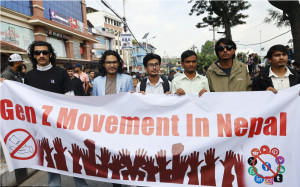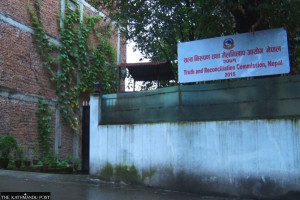Columns
Save our water springs
Springs have provided water to our communities for ages, and we are destroying them.
Kribina Pathak
Springs, a naturally emanating groundwater source, are drying up at an alarming rate in Nepal. Over the last decade, they have been changing their behaviour from perennial to seasonal. This situation can be seen across the whole country. Desiccating springs, despite their huge impact, have not yet been recognised as a disaster. Spring water is a crucial hydrological supplement for natural and societal existence in Nepal. The water flowing out of springs holds the highest value during the non-monsoon season as a base flow to the river systems. During the dry period, discharge from springs keeps the rivers flowing—sustaining livelihood and energy demands. The scale of the contribution of snow and springs to Nepal's river systems has not been clearly understood, however, it is apparent that river systems are heavily dependent on springs.
Drinking water and irrigation water supplement in almost all hill regions are directly dependent on springs. Not only this, the high value of this system can be implicitly understood by observing the historical settlements which are concentrated around spring water sources. Nonetheless, the socio-political situation is destroying these traditional water sources.
Unsustainable development
Unsustainable and unplanned developmental activities and urbanisation are threatening spring sources. Disorganised road construction, the pavement of water research zones, sand mining, deforestation, and more notably, hydropower development are leading to the destruction of springs. Urbanisation without considering the hydrological system and encroachment of areas near springs is worsening the situation. We need not go far to see an example of urbanisation induced drying: The waterless hitis of the Kathmandu Valley are a vivid reminder of how we have disrupted groundwater flows.
Quick fixes are being prioritised over sustainable sources. Technology facilitating the withdrawal of water from the rivers in the hills is leading to declining attendance in the conservation springs. It is easy to lift water with sophisticated technology, but the supplied water is obtained at a profoundly expensive rate. The cost of the electricity consumed for pumping water from the rivers to the hills pushes up the price. Furthermore, unlike spring water, river water requires extra physiochemical and biological treatment. The cost of treatment raises the price of water per litre. Ironically, we are abolishing the purest form of water and spending millions on treating water from secondary sources, principally from unsustainable sources such as confined aquifers.
The millennium's biggest challenge—climate change—has become another principal threat to spring sources. Variable rainfall patterns and high-intensity rainfall cuts groundwater recharge. Under the circumstances of climate change, aquifer recharge is restricted—leading to a decrease in the groundwater level and parched water sources. On the other hand, climate change has increased the demand for water. Higher temperatures and prolonged droughts have amplified the water requirement for irrigation, intensifying the withdrawal of groundwater. This is where the major concern lies. Aquifers extend across geographical regions. For instance, aquifers in the Siwaliks are directly connected with aquifers in the Tarai, and any alteration in the aquifer system at one place causes serious implications at another place.
Depleting water sources are hitting communities hard, resulting in compromised water availability, sanitation and hygiene, and worsening the health status. Additionally, the drinking water supply is tied with the livestock and kitchen garden. With decreasing water availability, raising livestock is quite impossible, creating the ground for food insecurity and economic burden and loss of indigenous knowledge. Women having culturally fulfilled their responsibility as water provider to the house. They are facing more drudgery—one out of 10 women in Nepal is subject to the risk of uterine prolapse. Many cases of the whole village being forced to relocate due to a water crisis have been reported across the country. Migration to the cities and plains is adding stress to groundwater sources.
At the rate springs are vanishing, people will become more dependent on flowing water—setting the stage for possible conflict over water sharing rights. At the same time, inter-basin transfer of water is rising, like the Melamchi drinking water project, which can sow the seeds for such tensions.
Groundwater is a complex science, hence a high technical capacity is required. Despite being heavily dependent on groundwater, none of the universities in Nepal offers a course purely dedicated to groundwater studies, namely hydro-geological studies. Groundwater has also received apathy in the policies from the federal level. There is no single policy solely dedicated to conserving groundwater. On top of that, water resource policies barely highlight groundwater management. After 1980, aquifer mapping has come to a halt.
Administrative system
The structure of municipalities and rural municipalities reflects a subtle intention to transform rural structures into an urban setting. The development pattern is most likely to replicate the orthodox style of haphazard development. Consequently, the same story of adding a burden to natural sources is expected. However, the advantage of the new structure is that the authority to manage natural resources lies at the local level. Each local government can play an active role in conserving water sources, like the inspirational examples set by a few municipalities. Above all, spring and groundwater conservation needs to be recognised at the national level policy.
Moreover, any developmental activity should consider the hydro-geological system and pay special attention to spring water. One of the visible requirements for the health of our groundwater is spring sources. The drying up of spring sources is an indication of a soft emergency. Hence, it is vital to develop policy, programmes and education directed towards spring conservation, both at the local and federal levels.




 22.12°C Kathmandu
22.12°C Kathmandu















